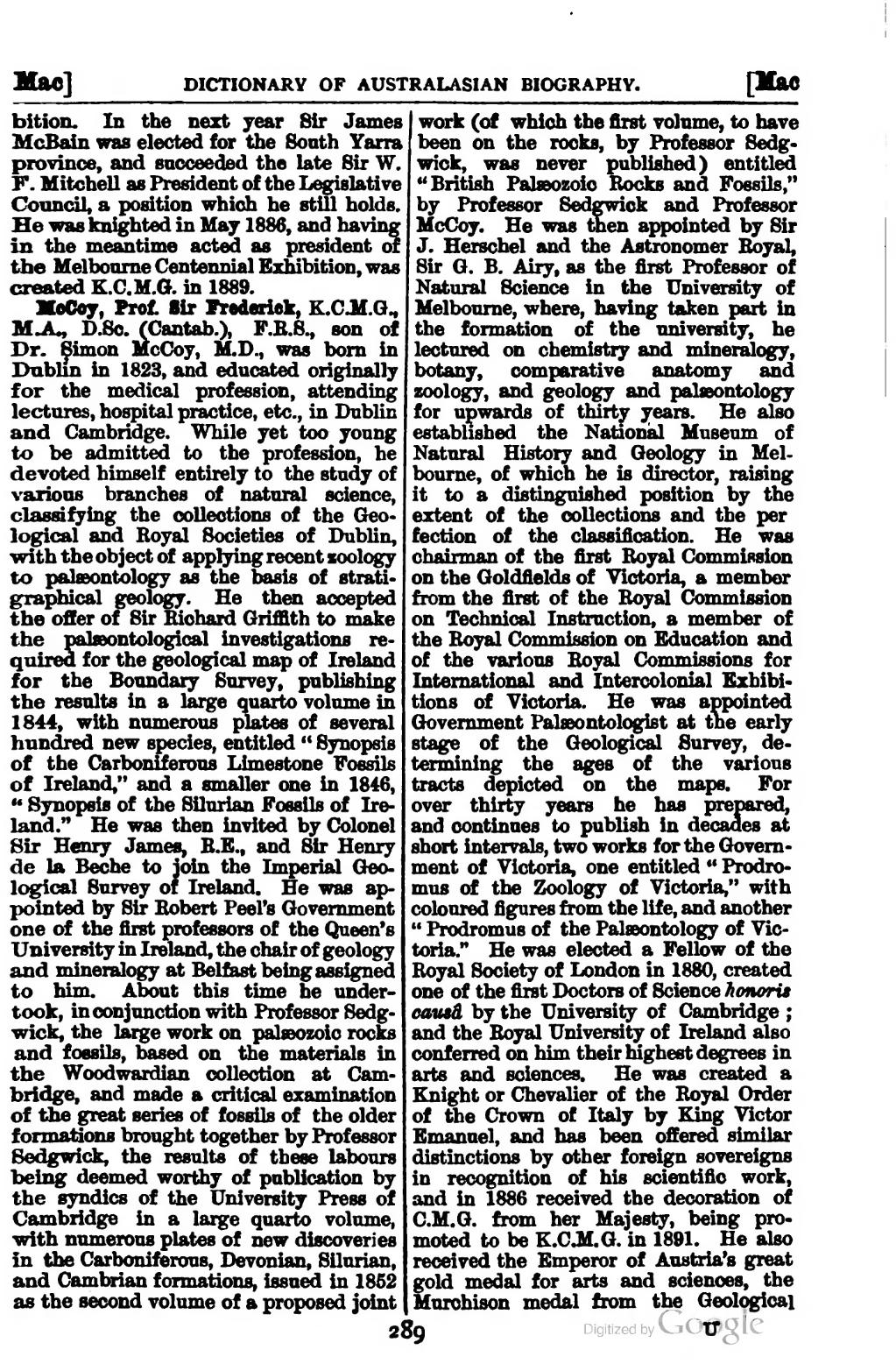bition. In the next year Sir James McBain was elected for the South Yarra province, and succeeded the late Sir W. F. Mitchell as President of the Legislative Council, a position which he still holds. He was knighted in May 1886, and having in the meantime acted as president or the Melbourne Centennial Exhibition, was created K.C.M.G. in 1889.
McCoy, Prof. Sir Frederick, K.C.M.G., M.A., D.Sc. (Cantab.), F.R.S., son of Dr. Simon McCoy, M.D., was born in Dublin in 1823, and educated originally for the medical profession, attending lectures, hospital practice, etc., in Dublin and Cambridge. While yet too young to be admitted to the profession, he devoted himself entirely to the study of various branches of natural science, classifying the collections of the Geological and Royal Societies of Dublin, with the object of applying recent zoology to palæontology as the basis of stratigraphical geology. He then accepted the offer of Sir Richard Griffith to make the palæontological investigations required for the geological map of Ireland for the Boundary Survey, publishing the results in a large quarto volume in 1844, with numerous plates of several hundred new species, entitled "Synopsis of the Carboniferous Limestone Fossils of Ireland," and a smaller one in 1846, "Synopsis of the Silurian Fossils of Ireland." He was then invited by Colonel Sir Henry James, R.E., and Sir Henry de la Beche to join the Imperial Geological Survey of Ireland. He was appointed by Sir Robert Peel's Government one of the first professors of the Queen's University in Ireland, the chair of geology and mineralogy at Belfast being assigned to him. About this time he undertook, in conjunction with Professor Sedgwick, the large work on paleozoic rocks and fossils, based on the materials in the Woodwardian collection at Cambridge, and made a critical examination of the great series of fossils of the older formations brought together by Professor Sedgwick, the results of these labours being deemed worthy of publication by the syndics of the University Press of Cambridge in a large quarto volume, with numerous plates of new discoveries in the Carboniferous, Devonian, Silurian, and Cambrian formations, issued in 1852 as the second volume of a proposed joint work (of which the first volume, to have been on the rocks, by Professor Sedgwick, was never published) entitled "British Palaeozoic Rocks and Fossils," by Professor Sedgwick and Professor McCoy. He was then appointed by Sir J. Herschel and the Astronomer Royal, Sir G. B. Airy, as the first Professor of Natural Science in the University of Melbourne, where, having taken part in the formation of the university, he lectured on chemistry and mineralogy, botany, comparative anatomy and zoology, and geology and palæontology for upwards of thirty years. He also established the National Museum of Natural History and Geology in Melbourne, of which he is director, raising it to a distinguished position by the extent of the collections and the perfection of the classification. He was chairman of the first Royal Commission on the Goldfields of Victoria, a member from the first of the Royal Commission on Technical Instruction, a member of the Royal Commission on Education and of the various Royal Commissions for International and Intercolonial Exhibitions of Victoria. He was appointed Government Palæontologist at the early stage of the Geological Survey, determining the ages of the various tracts depicted on the maps. For over thirty years he has prepared, and continues to publish in decades at short intervals, two works for the Government of Victoria, one entitled "Prodromus of the Zoology of Victoria," with coloured figures from the life, and another "Prodromus of the Palæontology of Victoria." He was elected a Fellow of the Royal Society of London in 1880, created one of the first Doctors of Science honoris causâ by the University of Cambridge; and the Royal University of Ireland also conferred on him their highest degrees in arts and sciences. He was created a Knight or Chevalier of the Royal Order of the Crown of Italy by King Victor Emanuel, and has been offered similar distinctions by other foreign sovereigns in recognition of his scientific work, and in 1886 received the decoration of C.M.G. from her Majesty, being promoted to be K.C.M.G. in 1891. He also received the Emperor of Austria's great gold medal for arts and sciences, the Murchison medal from the Geological
289
